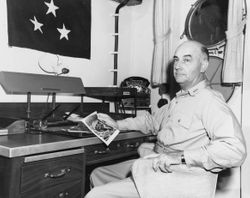Born on June 28, 1894 in Oregon. From FIND A GRAVE: US Navy Admiral. His military career spanned World Wars I and II, and the Korean War. After completing high school in 1911, he was selected to attend the US Naval Academy at Annapolis, Maryland, graduating in June 1915 and was commissioned with the rank of ensign. He then served consecutively on the armored cruiser USS South Dakota, the transports USS St. Louis, and the USS Glacier until September 1917. After assisting in fitting out the destroyer USS Stevens at Quincy, Massachusetts, he became the Engineer Officer upon her commissioning in May 1918. In October 1919 he was assigned as Executive Officer on the destroyer USS Shubrick, and participated in the Haitian Campaign. He later commanded the USS Shurbrick and in April 1920, transferred to the destroyer USS Meyer as Executive Officer until September 1921. From 1921 to 1923 he was an instructor in the Department of Marine Engineering and Naval Construction at the US Naval Academy, then returned to sea duty on the battleship USS California until 1925, when he was assigned to the Battle Fleet staff. From 1927 until 1940 he served twice at the US Navy Department in Washington DC, twice on seagoing flag staffs, on the battleship USS New York and heavy cruiser USS Portland, and at the 12th Naval District at Mare Island in Vallejo, California. In 1940 he became the Executive Officer of battleship USS Arizona until January 1941 when he assumed command of the light cruiser USS Trento, and was in command of that vessel in the Southeast Pacific when the US entered World War II in December 1941. In May 1942 he returned to the US and was assigned to the Office of the Chief of Naval Operations, Washington DC, until late 1943, when he became Chief of Staff to Rear Admiral Alan G. Kirk, who was responsible for US Navy participation in the Normandy Invasion of June 1944. He was promoted to the rank of rear admiral and in August 1944 he was assigned to command a 7th Fleet amphibious group, in the Pacific Theater, and participated in the invasion of Leyte the following October. Over the next several months, he commanded or participated in landing operations at Ormoc Bay, Mindoro, Luzon and elsewhere in the Philippine Islands. In September 1945, following the end of World War II, he commanded the Pacific Fleet's mine force as it began the long process of clearing mines from the former combat zone. From 1946 to 1948 he then commanded the Amphibious Force, Pacific Fleet. In April 1948 he was promoted to the rank of vice admiral and became the Deputy Chief of Naval Operations in Washington DC and In May 1950 he took command of the US 7th Fleet and led it through the difficult first year of the Korean War, including the landings at Inchon and Wonsan. In March 1951 he became Commander, US 1st Fleet, then served briefly with the Joint Chiefs of Staff in Washington DC. In May 1952 he became the US Naval Representative on the Military Staff Committee of the United Nations (UN) in New York City, New York, followed in July 1953 as the Chairman of the US Military Delegation to the Military Staff Committee of the UN. In June 1955 he became Commander Eastern Sea Frontier and Commander Atlantic Reserve Fleet, and retired in this position in July 1956 with 41 years of continuous military service. Among his military decorations and awards include the Distinguished Service Cross, the Navy Distinguished Service Medal with gold star, the Army Distinguished Service Medal, the Legion of Merit with two gold stars, the Commendation Ribbon with bronze star, the World War I Victory Medal, with destroyer clasp; the Haitian Campaign Medal, the American Defense Service Medal with fleet clasp, the American Campaign Medal, the European-African-Middle Eastern Campaign Medal with one star, the Asiatic-Pacific Campaign Medal with silver star (five engagements), the World War II Victory Medal, the Navy Occupation Service Medal, the China Service Medal, the National Defense Service Medal, the Mexican Service Medal, the Korean Service Medal, the United Nations Service Medal, and the Philippine Liberation Ribbon with two stars. His foreign decorations and awards include the French Legion d'Honneur, Rank of Officer, the French Croix de Guerre with Palm, the Greek Royal Order of the Phoenix, Higher Commander, the Belgian Commander of the Order of Leopold with Palm, the Belgian Croix de Guerre with Palm, and the Korean Order of Military Merit with Silver Star. He was then promoted to the rank of admiral on the retired list for having been especially commended in combat in accordance with an Act of Congress passed on March 4, 1925 and February 23, 1942 (colloquially known as a "tombstone promotion"). He died at the age of 88.

PRIVATE CITIZENS SUPPORTING AMERICA'S HERITAGE
American
War Memorials Overseas, Inc.
War Memorials Overseas, Inc.
Struble Arthur Dewey
Name:
Arthur Dewey Struble
Rank:
Admiral
Serial Number:
Unit:
VISAYAN ATTACK FORCE
Date of Death:
1983-05-01
State:
Oregon
Cemetery:
Arlington National Cemetery Arlington, Arlington County, Virginia
Plot:
Section 2, Lot 4737-E R
Row:
Grave:
Decoration:
Comments:
